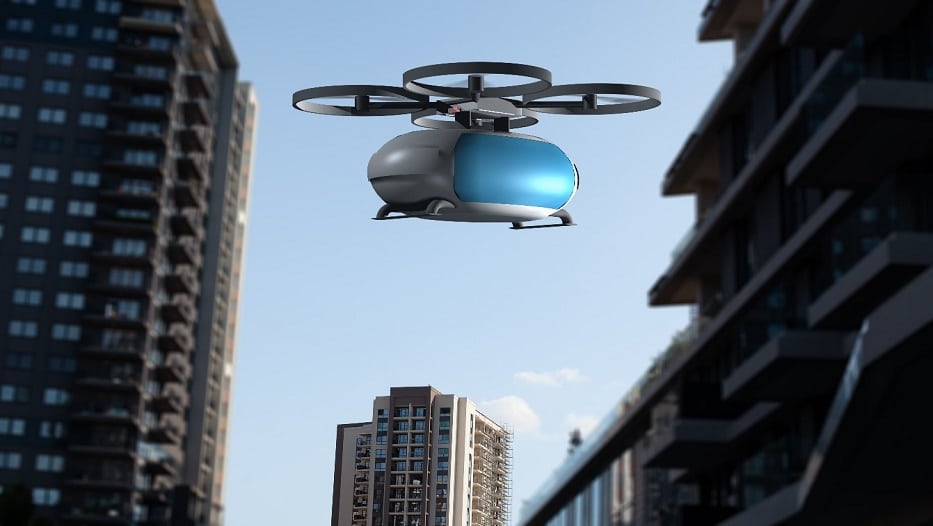Traditionally conceived as a long-distance travel route, air mobility is starting to find a place in the large cities of the world. With the potential to accommodate both passengers and supplies and goods, electrically propelled Vertical Take-Off and Landing Aircraft (eVTOL) have achieved an optimal level of development with the highest standards of sustainability envisaged in vehicles and infrastructure. Ángel Paris Loreiro, professor at the Department of Aerospace Systems, Air Transport and Airports of the Polytechnic University of Madrid, speaks to us about the future of urban mobility.
After many years of research and development, short-distance urban aviation is getting closer and closer to being a reality in the large cities of the world. In Asia there are projects that will be launched by 2025, while Europe has a proactive regulatory body and numerous manufacturers of electric aircraft called eVTOL (electrically propelled Vertical Take-Off and Landing aircraft). As a reference and base for these vehicles, the cities have to make room for the vertiports: infrastructures that will receive vertical take-off and landing air operations, both for people and for supplies and goods. Ángel Paris Loreiro, PhD Aeronautical Engineer from the Polytechnic University of Madrid, enlightens us on the key factors involved in strengthening this new mode of urban mobility.
“The European Union Aviation Safety Agency has conducted studies to learn about the acceptance and the main concerns of citizens with regard to this means of transport. The results show an acceptance of more than 80% and about 70% desire for use, especially for the transport of goods. The results of these studies are being used to draft a regulatory framework to put in place by 2025,” he explains. This welcoming endorsement is supported by the inherent quality of air transport: speed, something which would help to decongest public roads and substantially reduce travel times. However, from its start-up to its popularization, there may be a transition, according to the expert, from “other uses such as tourists for tours or excursions”.
Regarding its integration in the cities, they have the advantage that the vertiports only require a reduced surface area, so they could make the most of available free spaces or rooftops. “Vertiports can be of two types: first, we would have the larger ones that will act as nodes of the network, which could be located at the ground level with a series of associated facilities, taking advantage of areas available in the urban environment; while a second type would be isolated smaller vertiports that could be located on the roofs of the main buildings of the urban centers and which would require fewer support facilities,” Paris Loreiro says.
Large initiatives around the world
The development of the vertiports is linked to the vehicles they serve and, although it is still early to evaluate the real success stories, there are countless initiatives and projects, through which manufacturers try to position themselves for the future. “There are advanced prototypes such as Airbus (EU), Boeing (US), Embraer, EHang (China), Hyundai (Korea), or startups such as Lilium and Volocopter (Germany) or Joby (US), among others. In order for these prototypes to operate, they will need a certification, as will the pilots or the operators themselves. The industry and its regulators and supervisors have to go hand in hand in order to move forward,” says the UPM Doctor.
In Europe, in April of the same year, Urban-Air One will open in Coventry (UK), an initiative by Urban-Air Port and Hyundai – initially as an exhibition and for the Commonwealth games in Birmingham – while Ferrovial with the startup Vertical Aerospace, which has announced the construction of 25 vertiports in the future also in the United Kingdom, aspires to design, build and operate the set of infrastructures necessary for the operation of flying taxis, electrically propelled vertical take-off and landing aircraft in Spain.
Paris Loreiro assures that the market potential is very broad, since it can be consolidated as the rapid transport of people and goods in the city. “Their target market will be the one that generates the greatest added value in order to absorb the difference in costs compared to traditional transport. Studies show that citizens particularly value their usefulness for urgent transportation in the event of medical need, whether it be for personal needs or for injuries or other needs,” he says. In a demographic context where the tendency continues for populations to concentrate in cities, these services could become a guarantee of well-being. “For their initial development, they have the advantages of their flexibility and scalability to adapt to the needs, as these could be temporary and could even be deployed in association with specific events,” says the expert.
In addition to operational advantages, eVTOL could become a key instrument for the environment. “Although the number of users who can make use of them will not be as high as in other means of transport, we’re talking about infrastructures of a contained size, whose user aircraft produce zero emissions locally and have a low acoustic impact, which is a clear argument for sustainability,” says López Loreiro, adding that they will also favor intermodality and will offer an alternative means of transport to the land that can help to reduce the traffic in the large cities, both inside and in the surrounding areas.
Challenges of implementation
As with the other modes of electric transport, the development of eVTOL advances alongside the technology of the batteries and the accuracy of navigation. “Logically, it will be necessary to have a prior certification process for aircraft, pilots and operators for which the regulation has yet to be developed,” says the UPM professor, who recalls that the great challenge of air transport is always to ensure safety, both in the operational sense and in the sense of protection against illicit acts. “This is the main challenge of the regulatory framework that is being developed, as citizens must perceive that they are a safe means of transport so that their future is viable.” As the aircraft is electrical, it will have different dynamic behaviors and therefore different in-flight control capabilities that will have to be taken into account in the airspace design and management procedures. This will involve a technical evolution: initially the operations will be carried out with pilots on board, then remotely, and eventually in the long term, autonomously.
The safety issues will be virtually undetectable in the design phase of the vertiports, since their integration in the urban landscape will not require major alterations. “We are talking about a much simpler infrastructure than a conventional airport, where landing and take-off operations are vertical rather than horizontal, and the maneuverability of eVTOL is much better. They can be located on rooftops of buildings, along with transport infrastructures, integrated in logistics zones, in clear areas, rural areas or by reusing disused areas,” proposes Paris Loreiro.
While the advance in urban air mobility profiling is fast and safe, the expert says it is still too early to speak of immediate activation, although we are witnessing a “proliferation of partnerships between eVTOL manufacturers and infrastructure operators, seeking economic or technical synergies after which, possibly in the medium or long term, only the strongest contenders will be consolidated.” In this roadmap, the UPM professor believes that the predictable thing is that “vertiport networks will be established in densely populated urban centers and among those that are close to each other. For this, it will be essential to develop the autonomous and decentralized systems of Unmanned Air Traffic Management (UTM) and their integration into the existing system.” Due to the prototypes in place and the objectives of the regulatory and supervisory bodies, the first milestone in their implementation could be in 2025, with the provision of certified prototypes, operators and pilots. From 2030 they could be a reality. “The ultimate goal should be to make passenger transport by autonomous vehicles possible in the long term,” he concludes.
Article Collaborator:
 Ángel París Loreiro has a PhD in Aeronautical Engineering from the Polytechnic University of Madrid (UPM), is the director of the Master’s degree course in Aeronautical Systems Management and head of coordinating teachings in the subject of airports at the Superior Technical School of Aeronautical and Space Engineering at the same institution. He is a Senior Professor at the University, assigned to the Department of Aerospace Systems, Air Transport and Airports of UPM.
Ángel París Loreiro has a PhD in Aeronautical Engineering from the Polytechnic University of Madrid (UPM), is the director of the Master’s degree course in Aeronautical Systems Management and head of coordinating teachings in the subject of airports at the Superior Technical School of Aeronautical and Space Engineering at the same institution. He is a Senior Professor at the University, assigned to the Department of Aerospace Systems, Air Transport and Airports of UPM.
He has more than 20 years of teaching experience at UPM, leading numerous international courses and seminars on airport planning, construction and operations, both in Spain and Latin America, and more than 25 years of practice in consulting and engineering within the Airport Infrastructures sector. He has participated in important developments carried out in Spain, occupying positions of responsibility in engineering of the sector.




